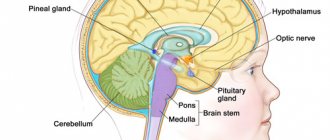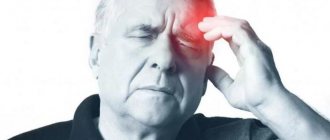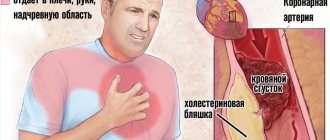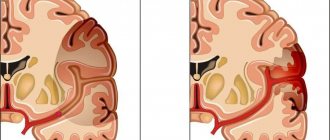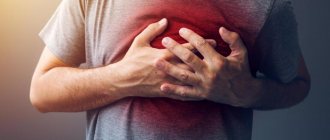According to the standards established by the World Health Organization, normal blood pressure ranges from 100 to 139 (systolic or upper reading) to 60-89 (diastolic or lower reading). Stage 3 hypertension is characterized by a persistent increase in blood pressure above 180 to 110 mmHg. Art.
The condition poses a tremendous danger to health and life: the risks of heart attack, stroke, blindness, and sudden cardiac death range from 40 to 60% and even higher.
Therapy for such a condition presents considerable difficulties due to the restructuring of the body in a pathological way.
The correction is carried out under the supervision of a group of specialists: a cardiologist, neurologist, nephrologist and endocrinologist, since the problem is of a systemic polyetiological nature.
According to statistics, stage 3 hypertension affects 10 to 12% of all diagnosed patients.
The average time for pathology to transition to the final stage (from the onset of the disease to transformation into the terminal phase) is 6-8 years without treatment.
Third degree
It is important to distinguish between stage 3 hypertension and stage 3.
The degree is the level of increase in blood pressure.
The stage takes into account the progression of the disease and organ damage.
In stage 3, upper blood pressure reaches 180 mm Hg. Art., lower – exceeds 110 mm Hg. Art. Possible presence of a stroke, heart attack, heart failure, angina pectoris, nephropathy, renal failure, aneurysm, arterial damage, retinopathy, diabetes.
This stage is the most difficult. It threatens problems with blood vessels, as blood pressure is constantly rising. Atherosclerosis develops in large vessels. The disease manifests itself especially clearly during the period when the hypertensive patient does not take medications. Then the picture of the disease is as expressive as possible.
Only a doctor can make an accurate diagnosis. Treatment will be prescribed by a cardiologist. The treatment regimen is described in detail. The results of diagnostics and tests must be taken into account.
Why is hypertension dangerous?
The pathology is dangerous because heart attacks and strokes that occur annually due to hypertension make many people disabled. Often the consequence of a heart attack or stroke is death. In addition, the danger lies in the fact that a person:
- Kidney failure may develop;
- Vision is impaired due to the fact that the retina is poorly supplied with blood;
- Left ventricular failure occurs, which carries the risk of pulmonary edema;
- There is a risk of sudden death.
Every hypertensive patient diagnosed with stage 3 runs the risk of having a heart attack (occurs in 40% of cases). Also, the third degree carries the risk of crises, when blood pressure readings jump to unacceptably high values. A hypertensive attack is extremely dangerous, as it can cause pulmonary edema and sudden death.
Risk level
The degree of risk is the possible complications and their likelihood. These are heart complications. With the development of the third degree of hypertension, it is the complications in the heart that become the most dangerous. This is a direct threat to the patient's life.
With stage 3 hypertension, 35% of all cases lead to target organ damage. This is the so-called 4th risk group. In such patients, the nerve centers are affected, tactile sensitivity is reduced, thinking and memorization are impaired. With such symptoms, the patient must be urgently hospitalized and treated. You absolutely cannot treat yourself!
IMPORTANT! Blood pressure may spontaneously return to normal, but this does not mean that the patient does not need to see a doctor.
Drug therapy
Drug therapy for stage 3 hypertension is the only way to control blood pressure! Patients are forced to take medications for life. Severe cases of the disease are sometimes treatable only by taking two or more drugs.
When choosing a new drug, the patient is prescribed a small dose of the drug. This neutralizes some negative effects and allows you to evaluate the effectiveness of the drug itself. If normal tolerability of the drug is observed, its dose is increased.
Today, doctors recommend medications divided into 5 classes according to their effect on the disease:
- AT receptor blocking drugs (ARBs).
- Diuretic medications.
- Angiotensin-converting enzyme inhibitors (ACE inhibitors);
- β-blockers;
- Drugs are calcium antagonists (CA).
For combination therapy, additional drugs are used. For example, direct renin inhibitors and α-AB agonists of imidazoline receptors.
When carrying out long-term therapy, long-acting drugs are used. They provide blood pressure control throughout the day. In this case, the patient has stable blood pressure for 24 hours.
An increase in blood pressure itself or its fluctuations can negatively affect the health of internal organs. The areas most at risk are the kidneys, brain, blood vessels and heart. In each case, the vulnerability of a particular organ is individual.
All methods of therapy for stage 3 hypertension should be prescribed by the attending physician after the patient has undergone a full examination.
Self-medication or the use of traditional medicine will not improve the situation or even worsen it. Author of the article Svetlana Anatolyevna Ivanova, general practitioner
Causes
The main reason is hypertension. It can be a symptom or an independent disease. Most often, hypertension is the result of damage to internal organs (kidneys, vessels of the endocrine system).
According to conservative estimates, up to 40% of the entire world population suffers from hypertension. The risk of encountering this disease increases as the body ages. The risk of developing cardiovascular diseases also increases.
Most often, arterial hypertension is the result of hypertension. This is essential (primary) hypertension.
The task of doctors is to identify the true cause and prescribe treatment to eliminate it. With proper therapy, positive dynamics occur quite quickly.
Only in 5-10% of all cases is it possible to establish the mechanism of development of hypertension. This is symptomatic hypertension. It is classified as reversible. The main thing is to find and eliminate the cause.
The main mechanisms for the development of hypertension:
- Neurogenic. It appears in obese patients, with heart failure, and in the early stages of diabetes. This activates the sympathetic nervous system.
- Vascular. Associated with dysfunction of the inner layer of blood vessels, deposits on their walls, blood clots, and decreased tone. The walls of blood vessels thicken over time, and their lumen narrows.
- Renal. The kidneys excrete sodium. This is how they regulate blood pressure. If kidney function is impaired, salts are excreted much more slowly. The volume of blood plasma increases, which leads to an increase in blood pressure. This factor is often associated with genetic predisposition.
- Hormone. Hormones (aldosterone) are involved in the regulation of blood pressure. They are produced by the kidneys and adrenal glands.
Stages and risks of cardiovascular complications
Hypertension of the third degree is accompanied by an increased likelihood of cardiovascular complications (CVC).
According to the established classification, hypertension, depending on the degree of the pathological process, has a certain risk of cardiovascular complications:
- The first stage of hypertension is an increase in blood pressure without affecting internal organs and systems.
- Stage two hypertension is an increase in blood pressure. At this stage, changes in the cardiac arteries and left ventricular hypertrophy are observed. However, the functions of the cardiovascular system remain unchanged.
- Stage 3 hypertension - accompanied by permanently high blood pressure and dysfunction of internal organs (cerebral circulatory disorders, hypertensive encephalopathy, renal dysfunction, hypertensive retinopathy).
- The fourth stage is a malignant form of hypertension, accompanied by increased diastolic pressure, severe pathological changes in the fundus, and progressive renal failure.
Arterial hypertension of the 3rd degree carries a potential danger to the life and health of the patient! According to statistics, this pathology causes death in 25% of cases in people over 40 years of age.
In this condition, the risks of atherosclerosis of the coronary artery are high, leading to heart attack, chronic heart failure and sudden coronary death.
Hypertension of the third degree is dangerous with serious complications
Risk factors
Essential hypertension is formed under the influence of various factors and mechanisms. There are a lot of them. There are 2 main groups of them:
- external;
- internal.
Blood pressure can increase due to several factors:
- alcoholism;
- smoking;
- mental disorders;
- physical inactivity;
- physical exercise.
Scientists have also identified additional risk factors:
- nutrition: salt in food and its high calorie content negatively affect;
- diabetes, metabolic syndrome, obesity;
- dyslipidermia. This is a violation of the proportions of harmful and beneficial lipids in the blood. The result is vascular atherosclerosis, increased blood pressure;
- pathologies of the kidneys, blood vessels, heart;
- gender, age: BP increases more often in older people. Men are more likely to suffer from hypertension. Women experience it after menopause;
- genetic predisposition: there are people who are genetically prone to the influence of provoking factors.
Prevention measures
The prognosis of the disease depends on its development and the occurrence of complications: stroke, myocardial infarction, heart or kidney failure. It is necessary to constantly monitor your blood pressure level and measure it every day. Preventive measures will help avoid the development or exacerbation of the disease.
It is recommended that you watch your diet first, as this is the most important cause of some symptoms. The doctor prescribes a diet according to test results and the patient’s health status. You should not eat later than two hours before bedtime. You definitely need to move and maintain an active lifestyle.
To reduce body weight and eliminate obesity, every day the patient should go for walks, jogging, swimming or aerobics. You can also ride a bike or visit a dance studio.
The harmful substances contained in cigarettes lead to the formation of free radicals in the blood. They change fat particles in the body, which allows them to be deposited on the walls of blood vessels and clog arteries. Alcohol causes veins to constrict, which increases blood pressure. Therefore, you need to fight your addictions.
It is worth reducing the amount of salt you consume. It contains a lot of sodium, which increases blood volume. The more fluid in the body, the higher the blood pressure rises.
It is also necessary to avoid stressful situations. Although this is a normal reaction to irritating factors and greater mental stress, its consequences for human health are disastrous. Stress affects the nervous system, which causes the arteries to narrow.
Symptoms
Often, high blood pressure occurs without obvious symptoms. Therefore, it is important to regularly measure blood pressure. This does not apply to stage 3 hypertension. Here the symptoms will definitely appear, and the condition will quickly worsen.
IMPORTANT! Never ignore the symptoms! This is extremely dangerous! With high blood pressure, the load on the heart increases significantly. This can lead to heart failure and even death.
Stage 3 symptoms:
- dizziness;
- headache;
- noise in the ears;
- heart pain;
- fatigue.
If a patient develops a crisis, the symptoms develop very quickly and increase.
Stage 3 Symptoms and Signs
Doctors identify the following clinical symptoms of stage 3 hypertension:
- respiratory dysfunction;
- severe headaches,
- nosebleeds;
- sleep disorders;
- attacks of dizziness;
- sensation of noise and ringing in the ears;
- edema, swelling of the face and lower extremities;
- hyperemia (redness) of the skin;
- excessive sweating;
- rapid heartbeat (tachycardia);
- heart rhythm disturbance;
- chronic fatigue syndrome;
- psycho-emotional instability;
- dyspnea;
- visual impairment;
- nausea and vomiting;
- weakness, decreased ability to work.
Unfortunately, most people do not pay special attention to the signs of hypertension, especially in the early stages. At the same time, the pathological process continues to progress. If you discover at least some of the symptoms of hypertension listed above, you must urgently consult a doctor, undergo a comprehensive examination and begin therapy!
Signs of hypertension
Hypertension 3 degrees: treatment
Treatment of stage 3 hypertension is not an easy task. It is best to engage in therapy at the stage when the pressure reaches 150 mm Hg. Art. (top). It is important to immediately change your lifestyle. If you have bad habits, now is the time to fight them.
Non-drug treatment
Drug treatment is prescribed only by a doctor. Traditional methods of treatment can only be additional to the main regimen.
It is very important to normalize body weight. Any extra kilogram provokes an increase in blood pressure. Hypertension is always observed in obesity. If the patient has taken care of the correct lifestyle and normalized body weight, this is already 50% of successful recovery and stable remission.
The right lifestyle will allow you to:
- remove dependence on medications;
- lower blood pressure;
- eliminate risk factors;
- provide prevention.
It is extremely important not only to take medications on time, but also to supplement treatment with non-drug therapy. These are special measures and restrictions that can improve the patient’s condition.
The algorithm of actions is as follows:
- We change our lifestyle. We ensure sufficient mobility, but avoid physical exertion. We start every day with light exercise.
- We give up possible bad habits.
- We take care of our psychological health and avoid stress. Doctors recommend spending less time in noisy, crowded places. You can’t sit for a long time at the computer or TV.
- Changing eating habits. It is necessary to reduce salt intake, add plant foods to the diet, which contain a lot of calcium, potassium, and magnesium. It is extremely important to control your weight. No extra pounds! If you already have them, you need to gradually lose weight. Make sure that the food is not excessively high in calories. Nutritionists have noticed that fruits can normalize blood pressure, so they should be included in the daily diet.
- We sleep more. Healthy sleep is the key to excellent well-being, physical and mental health. It should last at least 8 hours.
These measures are not at all complicated, but they are effective. The main thing is to find the willpower within yourself and overcome yourself.
Drug treatment
In case of grade 3 hypertension, you need to immediately reduce blood pressure. For this, the patient is given the appropriate drug. It is selected individually. Often it is a combination of drugs.
Drug treatment is provided by a therapist and cardiologist. If complications develop, the patient is treated by resuscitators. In case of cerebral stroke, treatment is assigned to a neurologist. It is important to take medications strictly according to the prescribed regimen.
You should not hope for a complete cure for stage 3 hypertension. This happens very rarely. Only if the increase in blood pressure is secondary, its cause is eliminated, does the chance of cure increase. It is very important that the patient seek help at the first signs of developing hypertension. If the third stage is advanced, it is completely impossible to cure it.
IMPORTANT! At stage 3, it is possible to control blood pressure only with the help of medications! This is the only effective way. Such patients are prescribed medications for life.
In severe cases, doctors are forced to prescribe several drugs. The doctor must be very careful when selecting medications, as they are quite strong. If there is a need to prescribe a new medicine, start taking it with a small dose. If the patient’s body responds adequately to the drug, the dose is gradually increased, bringing it to a therapeutically effective level.
There are currently 5 groups of drugs for the treatment of hypertension:
- Those that block AT receptors.
- Diuretics.
- β-blockers.
- Angiotensin converting enzyme inhibitors.
- Calcium antagonists.
Therapy must be comprehensive. The doctor selects a combination of drugs based on the condition of a particular patient. If long-term therapy is needed, long-acting medications are selected. Such prolonged-release drugs have a therapeutic effect throughout the day.
It is important to understand that high blood pressure causes a devastating blow to internal organs. Blood vessels, brain, heart, kidneys are affected. Each patient may suffer from a separate organ or several at once. Everything is very individual.
In grade 3, an ACE inhibitor is most often combined with a calcium antagonist and diuretic. This is antihypertensive therapy.
In addition to medications to lower blood pressure, medications are prescribed to lower blood sugar and platelet levels.
Treatment methods
Therapy is conservative, less often surgical. Consists of long-term use of pharmaceuticals:
- Diuretics. Eliminate excess fluid from the body. The most powerful are Hypothiazide, Furosemide, Veroshpiron.
- Calcium channel blockers. They do not allow Ca+ ions to penetrate into the vessels, which means there is no narrowing and blood flows easier. Verapamil, Diltiazem.
- Adrenergic blockers (alpha and beta). They reduce the sensitivity of special receptors to catecholamines, corticosteroids and other hypertensive substances. Carvedilol, Anaprilin.
- ACE inhibitors. Drugs in this group prevent the transformation of prehormones into full-fledged angiotensin-II, which is responsible for vascular stenosis. Prestarium, Perineva, Perindopril are used.
- Sedatives. To normalize the functioning of the central nervous system and accelerate inhibition processes. Diazepam and herbal medicines: motherwort, valerian tablets.
- Medicines to normalize blood flow. Aspirin, including the “cardio” modification. In strictly controlled dosages.
- Vitamin-mineral complexes (Aevit).
Surgeries are indicated for acute vascular stenosis, advanced atherosclerosis, kidney problems, tumors, malformations and aneurysms, and heart defects. This is a last resort.
A significant role is given to lifestyle changes:
- Quitting smoking, alcohol, overheating of the body, physical and mental overload.
- The maximum amount of alcohol per week is 150 ml.
- Normalization of drinking regime. 1.5-1.7 liters of clean water per day.
- Optimizing physical activity (two to three hours of walking a day, divided into two times: morning and evening). Exercise therapy under the supervision of a doctor.
- Changing your diet.
The last point involves limiting the amount of table salt (no more than 7 grams per day).
Authorized products:
- Vegetables.
- Fruits without restrictions.
- Lean meat (chicken and turkey breast).
- Soups based on broths from dietary poultry varieties.
- Cereals, porridge.
- Coarse bread.
- Natural sweets (dried fruits, honey, sugar-free jam).
- Nuts.
- Eggs (rich in healthy cholesterol).
- Butter (contains lecithin).
- Dairy products.
What not to eat:
- Sausages.
- Fat meat.
- Baking.
- Chocolate.
- Tea.
- Coffee.
- Energetic drinks.
- Snacks, fast food.
- Smoked meats, pickles, marinades, fried foods, semi-finished products, canned food.
- By-products (possible, but in limited quantities, especially liver).
Treatment table No. 10 is shown. If necessary, the diet is adjusted under the supervision of a nutritionist or at least an endocrinologist. It is possible to independently change the menu, taking into account the named permitted and prohibited products.
Diagnostics
To identify the severity of hypertension and determine damage to internal organs, laboratory and instrumental studies are used:
- Blood analysis. With arterial hypertension, there is an increase in cholesterol levels. This is due to the presence of low-density lipoproteins. Kidney damage can lead to an increase in urea, residual nitrogen, and creatinine.
- Fundus examination. During this procedure, the ophthalmologist sees tortuous and narrowed arteries that have a reddish tint. This is due to the reflection of light from a dense wall that has undergone sclerotic changes. The doctor may also detect hemorrhages in the retina.
- Consultation with a neurologist. This specialist may detect deterioration in the sensitivity of the limbs, decreased stability while walking, and impaired coordination of movements.
- Electrocardiogram. Using this procedure, it is possible to identify heart rhythm disturbances, muscle overload, and ischemia of certain areas of the myocardium.
- Ultrasound of the heart. This procedure helps to identify organ failure, muscle hypertrophy, and heart enlargement.
- Ultrasound of the kidneys. With the help of the study, it is possible to detect abnormalities in the structure of the tissues of the organ and a decrease in its volume.


